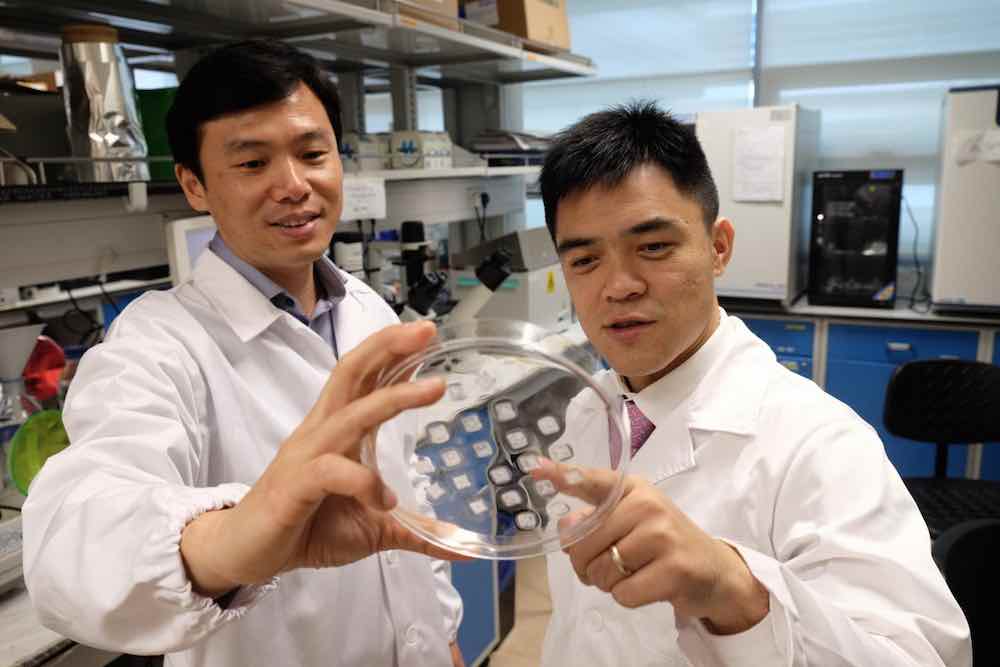A new approach to reducing bulging tummy fats has shown promise in laboratory trials. The solution aims to “use a person’s own body fats to burn more energy, which is a natural process in babies.”
Combining a new way to deliver medicine, via a micro-needle patch, with drugs that are known to turn energy-storing white fat into energy-burning brown fat, this innovative approach developed by scientists from Nanyang Technological University, Singapore (NTU Singapore) reduced weight gain in mice on a high fat diet and their fat mass by more than 30% over four weeks.
The new type of skin patch contains hundreds of micro-needles, each thinner than a human hair, which are loaded with the drug Beta-3 adrenergic receptor agonist or another drug called thyroid hormone T3 triiodothyronine.
RELATED: Woman Can Smell Parkinson’s Disease, May Lead To Breakthrough For Detection
As the needles degrade, the drug molecules then slowly diffuse to the energy-storing white fat underneath the skin layer, turning them into energy-burning brown fats.
Brown fats are found in babies and they help to keep the baby warm by burning energy. As humans grow older, the amount of brown fats lessens and is replaced with visceral white fats.
Published in the journal Small Methods recently by NTU Professor Chen Peng and Assistant Professor Xu Chenjie, this approach could help to address the worldwide obesity problem without resorting to surgical operations or oral medication which could require large dosages and could have serious side effects.
LOOK: This Font is Designed Specifically For Dyslexia – and it Really Works
“With the embedded micro-needles in the skin of the mice, the surrounding fats started browning in five days, which helped to increase the energy expenditure of the mice, leading to a reduction in body fat gain,” said Xu, who focuses on research in drug delivery systems.
“The amount of drugs we used in the patch is much less than those used in oral medication or an injected dose. This lowers the drug ingredient costs while our slow-release design minimizes its side effects,” said Xu.
Obesity which results from an excessive accumulation of fat is a major health risk factor for various diseases, including heart disease, stroke and type-2 diabetes. The World Health Organization estimates that 1.9 billion adults in the world are overweight in 2016 with 650 million of them being obese.
“What we aim to develop is a painless patch that everyone could use easily, is unobtrusive and yet affordable,” said Chen, a biotechnology expert who researches obesity.
CHECK OUT: Learn How to Spend Time Alone So You Can Unlock Your Creativity
Under the two scientists’ guidance at NTU’s School of Chemical and Biomedical Engineering, research fellow Dr Aung Than conducted experiments which showed that the patch could suppress weight gain in mice that were fed a high fat diet and reduce their fat mass by over 30%, over a period of four weeks.
The treated mice also had significantly lower blood cholesterol and fatty acids levels compared to the untreated mice.
Being able to deliver the drug directly to the site of action is a major reason why it is less likely to have side effects than orally delivered medication.
The team estimates that their prototype patch had a material cost of about S$5 (US$3.50) to make, which contains beta-3 adrenergic receptor agonist combined with Hyaluronic acid, a substance naturally found in the human body and commonly used in products like skin moisturizers.
MORE: From Terrifying to Terrific – Man Redesigns MRI Machine to Delight Children Instead of Scare Them
Beta-3 adrenergic receptor agonist is a drug approved by the U.S. Federal Drug Administration and is used to treat overactive bladders, while T3 triiodothyronine is a thyroid hormone commonly used for medication for an underactive thyroid gland.
Both have been shown in other research studies to be able to turn white fats brown, but their use in reducing weight gain is hampered by potentially serious side-effects and drug accumulation in non-targeted tissues if conventional drug delivery routes were used, such as through oral intake.
NTU’s Lee Kong Chian School of Medicine Associate Professor Melvin Leow, who was not affiliated with this study, said it is exciting to be able to tackle obesity via the browning of white fat, and the results were promising.
“These data should encourage Phase I Clinical studies in humans to translate these basic science findings to the bedside, with the hope that these microneedle patches may be developed into an established cost-effective modality for the prevention or treatment of obesity in the near future,” added Leow, an endocrinologist.
Since the publication of the paper, the team has received keen interest from biotechnology companies and is looking to partner clinician scientists to further their research.
(Source: Nanyang Technological University, Singapore)
Click To Share The Discovery With Your Friends – Photo by NTU Singapore




















